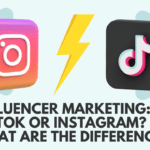Effectively spread content: we show you the challenges you face in micro-influencer marketing and how to solve them
Micro-influencers have loyal and highly active followers who show great interest in specific subject areas. Collaborating with these often less prominent influencers can therefore be more fruitful than cooperating with stars and personalities who have a wider reach. The challenges of micro-influencer marketing lie in identifying the right bloggers and contacting them with a well thought out strategy. We will show you how to achieve effective collaborations with micro influencers and thereby increase your reach and revenue.
Table of Contents
1. Defining your goals

- a higher number of followers in social media networks,
- more mentions/likes/shares on social media,
- an increase in the prominence of certain products,
- image cultivation,
- better Google placement
- or direct sales.
2. Defining the contents

3. Defining the budget

4. Selecting influencers

- whose personalities fit your brand,
- who focus on the right textual context,
- who have active followers, and
- who come across as especially authentic and trustworthy.
In other words: you must identify suitable influencers in a targeted way and consider whether they could represent your own brand. You can start by creating a micro-influencer longlist.
Micro-influencer longlist
To compile your list, search the social networks in which your customer base is especially active, focusing on relevant subject areas and locations. Generally, this should already yield some promising results, because micro-influencers’ account names or account descriptions often contain relevant keywords that point to their areas of interest and fields of activity. A glance at your own list of followers can also prove helpful, as it may include bloggers who meet your requirements for a collaboration. Plus, if these influencers already follow your brand, they are often happy to work with you.
Micro-influencer shortlist
The next step lies in turning your longlist into a shortlist that contains only the truly relevant micro-influencers. To narrow down your list, take a closer look at the candidates’ profiles and channels:
- Do their contents suit your brand?
- How active are the influencers’ followers?
In order to competently answer the first question, imagine your own brand content among the posts of the respective micro-influencer. If this gives you a positive impression, it is worth considering a collaboration with this influencer. To answer the second question, you should carefully examine the number of likes and comments per post. If the followers are especially active, you should keep the influencer on your list. When it comes to micro-influencer marketing, you’re looking for quality, not quantity.
In addition, you can look out for factors such as
- the readability of their texts,
- the quality of their pictures,
- their level of creativity, and
- how carefully theywork.
These aspects give you a good idea of the quality you could expect from the respective micro-influencer’s posts on your brand.
5. Contacting influencers

The second major challenge of micro-influencer marketing lies in finding the right way to contact opinion leaders. Be sure to present your brand or product honestly and passionately. This makes you appear authentic and trustworthy – qualities that also characterise influencers. Avoid giving the impression that they would be just a cog in your marketing wheel. Communicate with the bloggers on an equal footing and ask them about their price model. This lets them know straight away that you’re willing to pay a (small) amount for a collaboration.
You can simply send an email or message in your first attempt to contact an influencer. If they don’t respond, try sending a direct message to one of their social media accounts. No matter the channel, opt for a personal approach and writing style. For example, you could refer to their content or the style of the influencer account and thereby convey that you’re interested in their work. Let the influencer know:
- why you have selected them specifically,
- why they would be a good fit for your brand, and
- what a collaboration could look like.

6. Briefing influencers
Even if you already have a very precise idea of what you want a collaboration and the published content to look like, the campaign should be developed through a joint process with input from both parties. Make sure that you:
- comprehensibly communicate the advantages of your product,
- openly explain your expectations of the collaboration, and
- mention any applicable brand guidelines or other specifications (time, date, scope).
In turn, micro-influencers know their followers best and therefore know the type of content and posts that will achieve especially high levels of interaction. You should therefore grant them plenty of creative freedom. Too many restrictions and specifications prevent them from appearing natural and credible. By contrast, creative freedom allows them to create interesting content with a wide reach.
7. Checking and editing posts if needed

Even if you have discussed the posts in detail with the micro-influencers, you may still find that the result does not fully meet your expectations. Simply check the published posts to ensure that they fulfil the demands of your brand. Influencers are generally happy to make small amendments.
Take advantage of the potential of micro-influencers
SeedingUp provides support in designing effective influencer marketing campaigns with micro-influencers. On our platform www.seedingup.com, you can find authentic and influential micro-influencers who will present your brand according to your needs. The result: a substantial increase in the number of followers and thereby higher brand recognition.
Do you want to leave micro-influencer collaborations in our capable hands? Our experienced campaign managers will take care of every single step for you.




